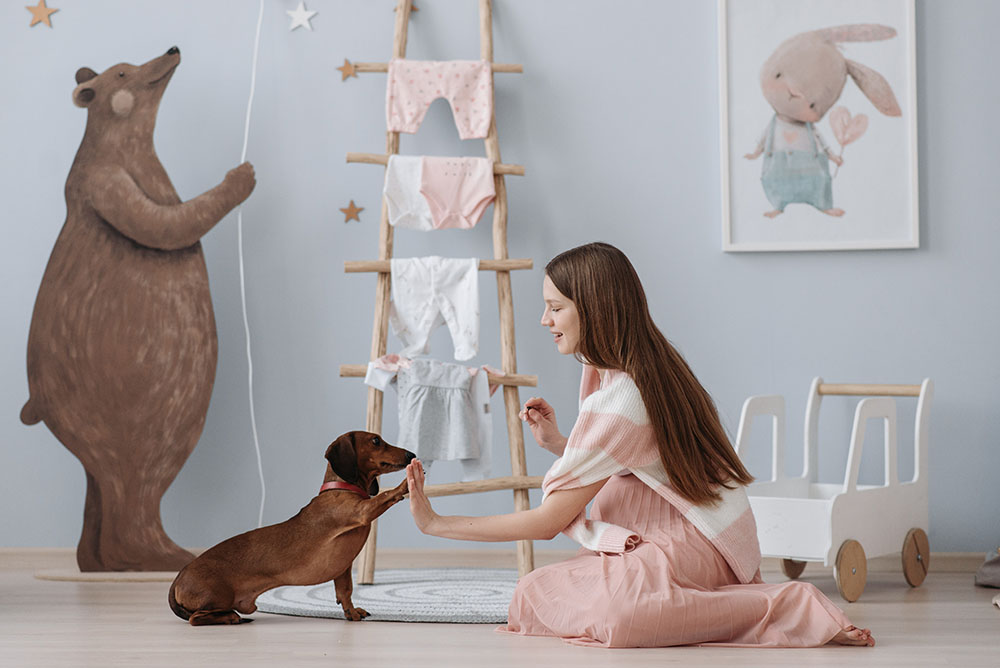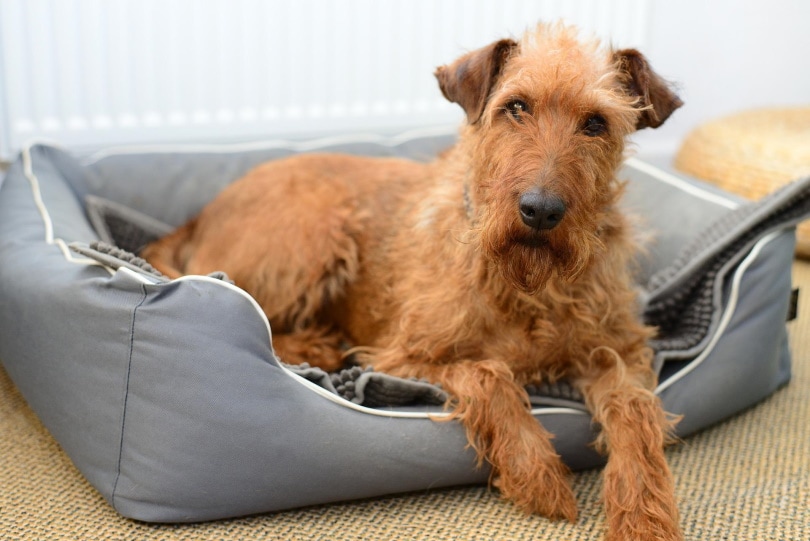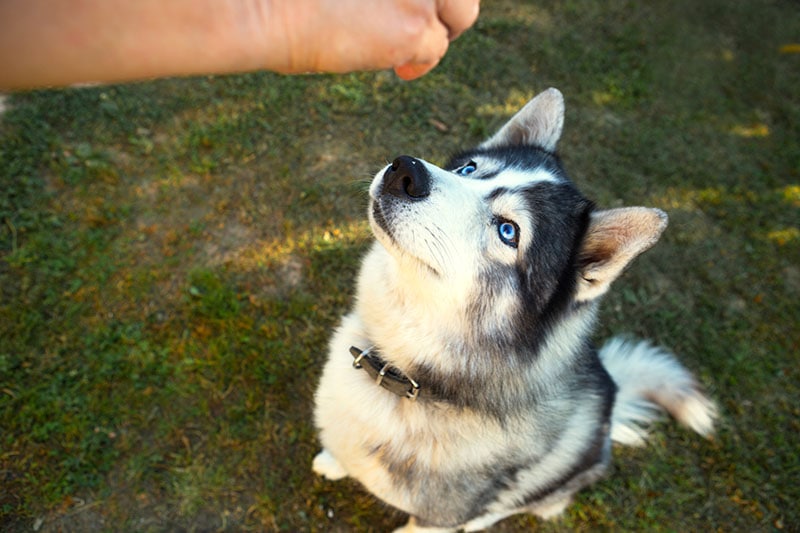How to Stop Your Dog from Begging for Food : 9 Vet-Approved Tips & Tricks

Updated on

Meal times at home can send your furry friend into a frenzy as the smells of human food entice them. As they look up at you with their big puppy eyes, begging for a small piece of food off your plate, some dog owners give in, hoping to get their pooch to stop begging.
But the problem arises when your dog doesn’t stop being interested after one bite and becomes insistent on getting more food. They can jump up on people eating at the table, scratch, bark, or just become a general nuisance. But how do you get your dog to stop begging?
Below are nine useful vet-approved tips you can try to help put a stop to unwanted begging.
The 9 Tips to Stop Your Dog Your Dog from Begging for Food
1. Basic Obedience Training
The cornerstone of all good dog behavior is basic obedience training. Teaching your dog the basics of sit, come, down, and stay may not seem related to begging at the table, but without an established communication with your pet, you will have a difficult time trying to explain to them what it is that you want them to do, in which case you can’t fault them, if you haven’t given them the “rulebook”.
A begging dog emotionally overcome by the smell of food can become annoying and insistent. A simple command like “sit” can help focus their attention and snap them out of their instinctual drive for some tasty smelling human food. Dogs who have never had any training simply do not understand what you want from them and what type of behavior is expected and rewarded. Basic command training creates a language for clear communication between you and your pet that helps both of you navigate the world around, while the rules are there to redirect your dog’s focus when they are overwhelmed by their instincts.
Basic training also builds a bond of trust between you and your pet over time. Researchers have found that using training to establish clear communication with your pet leads to a stronger and healthier human-pet relationship. This should always be based on positive reinforcement, so your dog will learn that certain behaviors, such as listening to a command, will mean that they will get rewarded, either with praise and attention or treats, and they will choose this behavior more often or whenever prompted. This way we encourage the desirable behavior we want to see, as opposed to reacting or punishing behavior we don’t want to see. Punishment should always be avoided as it may lead to fear-based behaviors and aggression.
2. Train Your Dog to Eat in a Different Room
A pro tip is to feed your dog in a different room from the dining area. This small tweak to their behavior has a couple of advantages. First, it helps to establish their food zone in a different part of the house. If they are consistently fed in this place away from the dining area, it will help them associate that room with their own meal and creates a clear distinction between your food and theirs.
Secondly, it gives them a clear sense of their own peace and quiet. As much as dogs love all things human, they also love to know that they have their special spots in the house that belong to them where they can relax without being bothered.

3. Feed Your Dog At the Time of Dinner
Feeding your dog at the same time that you would have your meals is a good way to lessen their anxiety and desire to beg around food at the table. Giving them their dinner establishes a clear routine that they can rely on, and redirects their attention to their own food. They can eat while your dinner is being served at the table and, at the same time, satiate their desire to be included at meal time.
After they have eaten and come back to the dining area, they are also more relaxed knowing that they have not been forgotten while everyone else is enjoying their meal. But this may not stop them from begging. Ensuring their food lasts longer is a way to keep them busy during your meal times. This can be achieved with a long lasting chew, food served in puzzle feeders or other enrichment toys.
4. Ignore Their Behavior
Most dogs have mastered the soulful look of aching cuteness that can cause you to cave in and offer a little something off your plate. It is so hard to resist! Nonetheless, resisting is important if you don’t want the behavior to avalanche and turn into a non-stop begging habit. Every time you feed your dog at the table, you are not just bending a rule. You are reinforcing to them that they will get a reward for begging behavior. To their minds, this is not a one-time nicety but a step in the training process.
Ignoring your dog when they turn to you with their puppy stare is the best way to play down the impact of their behavior and not feed their expectations. You can kindly redirect them to other activities such as lying down in their spot or going outside to look for squirrels.

5. Make Sure All Guests Ignore Their Behavior, Too
Ignoring your pet is typically effective unless you lack a united front from the people at the table. Ignoring your dog’s begging teaches them that this behavior will not get your attention or cause a reaction. At the table, all of the family members need to agree with the tactics you use to redirect your family pet. If you all use the same commands or key phrases, it helps your dog understand what you’re expecting of them, without causing any confusion.
It can be difficult when one person breaks the rules and changes the message to your pet. It can be meaningful and effective to initiate a conversation at the table with your family members to establish the basic ground rules for communicating with your pet.
6. Send Them to Their Own Spot
Dogs love a cozy bed and a place of their own. Setting up a bed for them with their toys in the corner of the dining space lets them feel included but have a place to go to calm down. Sometimes it’s not enough to just ask them to stop a certain behavior; you have to give them a good alternative with an activity they like to do. The command “stay” is useful as you train them to learn to go to their spot during meals. The first few times you ask them to go to their bed, you will have to also ask them to stay for a set amount of time before giving them a small reward. After a few tries, they should get the idea to go to their bed, as the behavior has been positively reinforced with food. It may take some time for your dog to fully learn this command, but make sure you persist and continue rewarding their successful efforts, while gradually increasing the time they stay on their bed.

7. Teach the “All Gone!” Command
Beyond the basic commands, sit, lie down, stay, etc., there is another command you can add to your training that can be extremely useful for begging: the “all gone” command. The all-gone command simply means that you let your dog know when a source of food (usually a special treat) has run out.
Have you ever given your dog a milk bone or other treat, and they come back seconds later sniffing around for more? An instinctive response is to lean forward and face your dog with open hands saying “All gone!” to let them know the treat is finished. They quickly sniff your palms to confirm and then disengage from the impulse to find more food. This can move from a natural interaction to a trained behavior if repeated over time.
Saying “all gone” in a calm but friendly tone tells them that no matter what they might be smelling, the food meant for them is finished.
8. Entertain Your Dog with a Delicious Treat
If all else fails, a sure-fire means of distraction is another source of food. Preparing a delicious treat for your pet to snack on while you all eat dinner can keep them occupied and happy. The snack needs to be time-consuming to eat so that it lasts throughout the meal, preferably that takes some effort to eat or that they can slowly chew on.

9. Another Solution: The Frozen Kong
A classic trick is the frozen Kong toy. The genius of the Kong is its hollow center that you can stuff with dog treats, like milk bones or jerky strips, and then top off with 2–3 tablespoons of xylitol free peanut butter, sealing the treats inside. Without the peanut butter, the dogs can get the treats out too quickly, but once frozen, the peanut butter slows them down, and they have to spend time licking the whole toy to discover what is inside.
Freezing is important as it makes it last longer and helps to protect the floors and carpet from the potentially disastrous effects of a sticky peanut butter treat. Also, remember that when prepping for meal time, you will need to also prepare the Kong in advance so it has time to freeze. It can be great to have a few on hand so you can prepare them all at once and have multiples frozen and ready to go. Remember to check with your vet first before feeding your dog anything unusual such as a new treat or peanut butter. Make sure it does not contain xylitol as an artificial sweetener, as it’s very toxic to dogs.
Conclusion
Training your dog to stop begging is a wise investment in peaceful mealtimes and creates a happy pet. As with any form of training, it is not about having a negative attitude toward your dog’s behavior as it is about the desire to build a stronger relationship with your pet. Good training creates clear communication and a mutual understanding of expectations. This allows trust to thrive and the attachment to deepen.
Your dog begs for food for multiple reasons, the most obvious being that it smells delicious, and they instinctively want to try it out. Less obvious is their need for attention and acknowledgment when the family is gathered together and interacting with one another. The tools you use to train your dog should take into account both of these aspects of the behavior. Feeding your dog at the table or not is a personal choice and whatever you decide to do around the table, just remember that what your pet most appreciates is consistency, positive reinforcement, and kindness.
Featured Image Credit: Javier Brosch, Shutterstock











